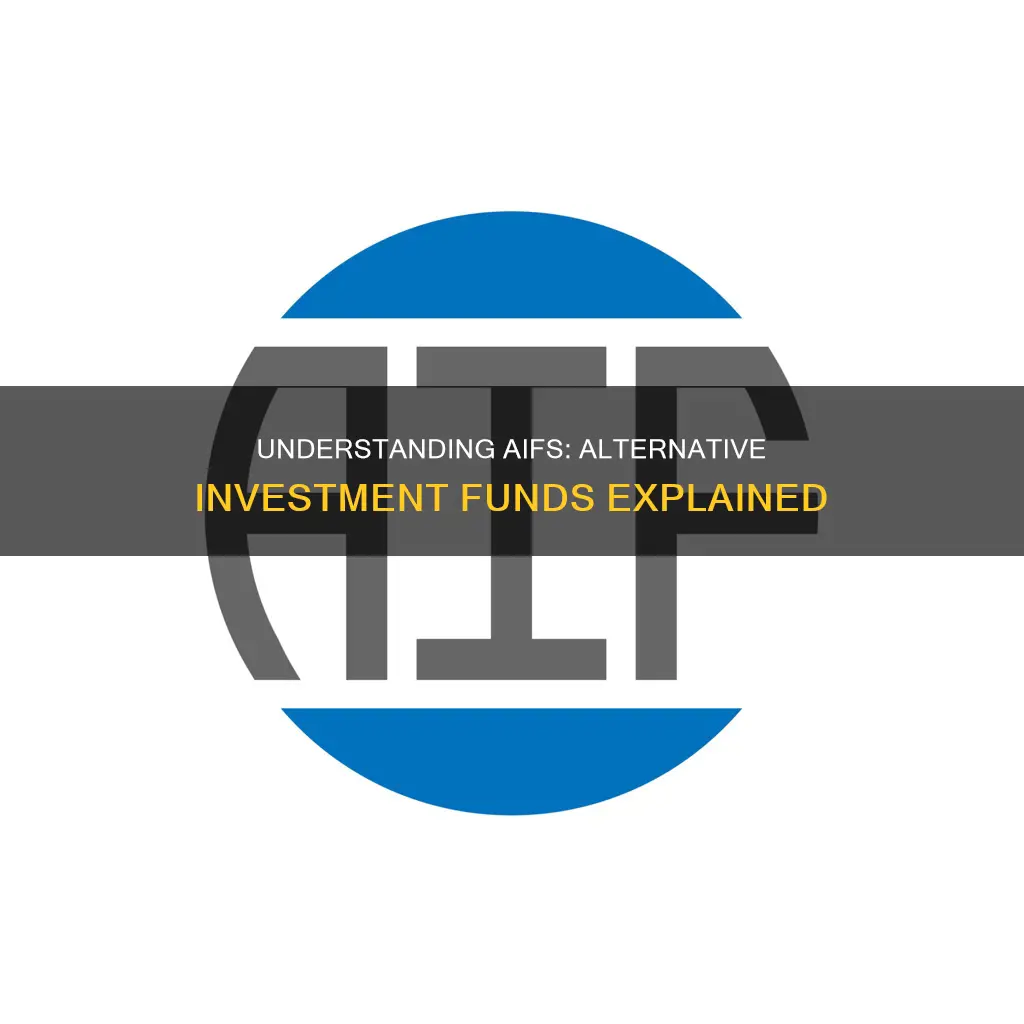
An alternative investment fund (AIF) is a collective investment scheme that is not covered by the directive on undertakings for collective investment in transferable securities (UCITS). AIFs are managed by alternative investment fund managers (AIFMs) and include investment funds such as hedge funds, funds of hedge funds, venture capital, private equity funds, and real estate funds. The aim of the AIF is to offer investors the opportunity to participate in a fund for collective investment, allowing unit-holders to share in the proceeds of the investments.
| Characteristics | Values |
|---|---|
| Definition | An alternative investment fund (AIF) is an investment in any asset class excluding capital stocks, bonds, and cash. |
| Directive | AIFs are not covered by the directive on undertakings for collective investment in transferable securities (UCITS). |
| Regulation | AIFs are managed by an Alternative Investment Fund Manager (AIFM) who must follow the Alternative Investment Fund Managers Directive (AIFMD). |
| Purpose | AIFs are often established for saving or income-generating purposes while supporting broader economic activity. |
| Types | AIFs include venture capital, private equity funds, real estate funds, hedge funds, funds of funds, and more. |
| Market | AIFs are available for trade on regulated markets such as Nasdaq Stockholm, Nasdaq Copenhagen, and Nasdaq Iceland. |
What You'll Learn
- AIFs are collective investment funds that are not covered by the UCITS directive
- AIFs are managed by AIFMs, who are authorised and supervised by the AIFMD
- Types of AIFs include venture capital, private equity, real estate, and hedge funds
- AIFs are established for saving or income-generation while supporting broader economic activity
- AIFs are distinct from traditional investments like stocks, bonds, and cash

AIFs are collective investment funds that are not covered by the UCITS directive
An Alternative Investment Fund (AIF) is a collective investment scheme managed by an Alternative Investment Fund Manager (AIFM). AIFs are a type of investment fund that is not covered by the directive on undertakings for collective investment in transferable securities (UCITS).
Current European law distinguishes two types of collective investment vehicles: UCITS and collective investment institutions that do not qualify as UCITS (AIFs). UCITS are subject to the UCITS Directive, which regulates managers of one or more UCITS, while AIFs are subject to the AIFM Directive, which regulates managers of one or more AIFs.
AIFs include a variety of investment funds such as hedge funds, funds of hedge funds, venture capital, private equity funds, and real estate funds. Danish Capital Associations are also considered AIFs and are subject to special regulation by Danish regulators.
AIFs are established for saving or income-generating purposes while supporting broader economic activity. They vary in terms of their investment strategies, markets, asset types, and legal forms. The capital collected by AIFs may not be used directly for operational activities.
The Alternative Investment Fund Managers Directive (AIFMD) provides a legal basis for AIFs, aiming to create uniform requirements throughout the European Union for the authorization and supervision of AIFMs. The AIFMD was adopted following the global financial crisis, which exposed weaknesses in global financial markets and regulatory regimes. As a result, there was an agreement on the need for greater regulation of the financial industry to minimize the risk and magnitude of future crises, including the alternative investment management sector.
Vanda Global Fund: A Guide to Investing Wisely
You may want to see also

AIFs are managed by AIFMs, who are authorised and supervised by the AIFMD
An Alternative Investment Fund (AIF) is a collective investment scheme managed by an Alternative Investment Fund Manager (AIFM). AIFs are a type of investment fund that is not covered by the European Directive on Undertakings for Collective Investment in Transferable Securities (UCITS). This includes hedge funds, funds of hedge funds, venture capital and private equity funds, and real estate funds.
AIFs are managed by AIFMs, who are authorised and supervised by the Alternative Investment Fund Managers Directive (AIFMD). The AIFMD is a legal framework that was established to create uniform requirements for the authorisation and supervision of AIFMs in the European Union. The directive was adopted following the global financial crisis, which exposed weaknesses in the regulatory regimes of global financial markets. As such, the AIFMD seeks to achieve a coherent supervisory approach to the risks of the financial system, provide high-level investor protection, and facilitate EU AIF market integration.
AIFMs are required to take measures to manage risks and ensure transparency regarding the activities of their managed AIFs. They are responsible for implementing a specified investment policy and investing the collected capital in the interest of the investors. The capital collected by AIFs may not be used directly for operational activities and is instead invested across various asset types and markets, depending on the fund's investment strategy.
The AIFMD also allows AIFMs to manage and market their funds to professional investors across the EU with a single authorisation. This authorisation is granted by the relevant regulatory authority, which in the case of the Netherlands, is the Netherlands Authority for the Financial Markets (AFM). DNB, De Nederlandsche Bank, advises the AFM on whether an investment vehicle meets the prudential requirements of the Financial Supervision Act.
Launching an Investment Fund: Legal Steps to Success
You may want to see also

Types of AIFs include venture capital, private equity, real estate, and hedge funds
An Alternative Investment Fund (AIF) is a privately pooled investment vehicle that offers investors the opportunity to participate in a fund for collective investment. AIFs invest in alternative asset classes beyond traditional investments such as stocks, bonds, and cash. Current European law categorises AIFs as collective investment vehicles that do not qualify as Undertakings for Collective Investment in Transferable Securities (UCITS).
Venture Capital
Venture capital funds invest in start-ups and early-stage companies with high growth potential. They seek innovative ideas, disruptive technologies, and talented entrepreneurs, providing funding, expertise, and networks to scale these businesses. Venture capital funds typically invest in a series of financing rounds, starting with seed funding and progressing to Series A, B, and C rounds. This type of investment is often high-risk but can offer high rewards, with some successful ventures generating significant returns that offset the losses from failed investments.
Private Equity
Private equity funds invest in private companies, typically buying controlling or significant minority stakes. They aim to generate returns by improving the operations, management, and financial performance of these companies, holding their investments for several years before exiting through a sale or an initial public offering (IPO). Private equity funds raise capital from institutional investors, such as pension funds, endowments, and wealthy individuals.
Real Estate
Real estate is one of the tangible assets that AIFs invest in. These investments can include a variety of property types, such as residential, commercial, industrial, or land. Real estate AIFs may invest in properties directly or through real estate investment trusts (REITs) or other investment vehicles.
Hedge Funds
Hedge funds employ a range of sophisticated investment strategies to generate returns, often with low correlation to traditional markets. They may invest in various assets, including stocks, bonds, commodities, currencies, derivatives, and other financial instruments. Hedge funds can use leverage, short-selling, and other techniques to amplify returns or hedge against risks. They are often managed by teams of investment professionals and may have more flexible trading strategies than other AIFs.
A Guide to Investing in US Index Funds from India
You may want to see also

AIFs are established for saving or income-generation while supporting broader economic activity
An Alternative Investment Fund (AIF) is a collective investment scheme managed by an Alternative Investment Fund Manager (AIFM). AIFs are established for saving or income-generation while supporting broader economic activity.
AIFs are a type of investment fund that is not covered by the directive on undertakings for collective investment in transferable securities (UCITS). UCITS are investment funds that raise capital from the public and invest it in liquid financial assets, such as capital stocks, bonds, and cash. On the other hand, AIFs include investment funds that collect capital from multiple investors and invest it in assets excluding traditional financial investments such as stocks, bonds, and cash. These alternative assets can include tangible items like precious metals, collectibles (e.g., art, wine, antiques), and some financial assets like real estate, commodities, private equity, and hedge funds.
The variety of investment strategies, markets, asset types, and legal forms employed by AIFs is extensive. They are established to generate income or support savings for investors and, at the same time, contribute to broader economic activity.
The establishment of AIFs is regulated by the Alternative Investment Fund Managers Directive (AIFMD), which was adopted after the global financial crisis exposed weaknesses in the regulatory regimes of financial markets. The AIFMD aims to create uniform requirements for the authorisation and supervision of AIFMs throughout the European Union. This directive ensures that AIFMs take measures to manage risks and maintain transparency in their activities, while also being able to market their funds to professional investors across the EU with a single authorisation.
In summary, AIFs are a type of investment fund that offers opportunities in assets outside of traditional financial markets. They are established with the dual purpose of generating income or supporting savings for investors, and contributing to broader economic activity. The regulation of AIFs through the AIFMD ensures that these funds are managed and marketed in a transparent and risk-managed manner within the EU.
Why Tracker Funds are a Smart Investment Choice
You may want to see also

AIFs are distinct from traditional investments like stocks, bonds, and cash
An alternative investment fund (AIF) is a collective investment scheme managed by an alternative investment fund manager (AIFM). AIFs are distinct from traditional investments like stocks, bonds, and cash.
AIFs encompass a range of investment undertakings, including its sub-funds, that collect capital from numerous investors. The capital is then invested according to a predetermined investment strategy, with the ultimate goal of benefiting the investors. Notably, the capital amassed through AIFs cannot be directly utilised for operational activities, setting it apart from traditional investments.
The AIFM Directive (Directive 2011/61/EU or "AIFMD") serves as the legal foundation for AIFs. This directive establishes uniform requirements across the European Union for the authorisation and supervision of AIFMs. The AIFMD was implemented to address vulnerabilities in global financial markets and regulatory frameworks exposed by the global financial crisis.
AIFs cover a diverse range of investment strategies, markets, asset types, and legal forms. Examples of AIFs include venture capital, private equity funds, real estate funds, hedge funds, and fund of funds. These funds are often established with saving or income-generating objectives while also contributing to broader economic activity.
It is worth noting that AIFs are subject to distinct regulatory frameworks. For instance, in the Netherlands, the authorising authority for AIFs is the AFM (Netherlands Authority for the Financial Markets), advised by DNB (De Nederlandsche Bank) on meeting the prudential requirements of the Financial Supervision Act.
Smart Mutual Fund Investments with 10 Lakhs
You may want to see also
Frequently asked questions
An Alternative Investment Fund is a collective investment scheme managed by an Alternative Investment Fund Manager (AIFM). It is an investment in any asset class excluding capital stocks, bonds, and cash.
Examples of AIFs include hedge funds, funds of hedge funds, venture capital, private equity funds, real estate funds, and commodities.
UCITS (undertakings for collective investment in transferable securities) are covered by the UCITS directive, whereas AIFs are not. UCITS raise capital from the public and invest it with specific restrictions, while AIFs raise capital from multiple investors and invest it according to a specified investment policy.







